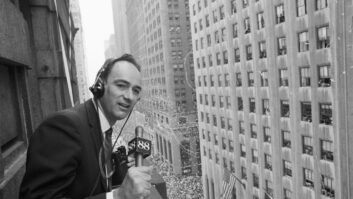Here’s a wrapup about the tower damage suffered last weekend in Pennsylvania, from TV Tech’s Doug Lung:
Sunday morning Wilkes-Barre Scranton Pennsylvania stations WNEP (ABC), WVIA (PBS) and WYOU (CBS) went off the air at 7 a.m.
NBC affiliate WBRE (NBC) lost its digital signal but the analog signal stayed up. Engineers at the stations didn’t immediately know what happened because the power went out when the stations went off the air. Arriving at the transmitter site on Penobscot Mountain, engineers found the 800-foot WNEP analog tower had completely collapsed. It damaged a transmitter building containing WNEP’s DTV equipment. The WNEP tower fell across power lines, knocking out power to the other stations, except for the WBRE analog transmitter, which was on a separate tower and power feed and unaffected. The top 150 feet of the WVIA tower had fallen, along with the WVIA DTV antenna.
The snow, sleet and freezing rain that led to the ice build up and the eventual collapse of the WNEP tower and partial collapse of the WVIA tower started late Saturday night. A combination of two storms, one from the Ohio Valley and one off the mid-Atlantic coast caused the bad weather, according to Mike Gorsea, meteorologist at the National Weather Service in Mount Holly, N.J., as quoted in an Allentown Morning Call article.
Penobscot Mountain is approximately 2,100 feet above sea level. Falling ice made repairs to equipment difficult, but, as is often the case, engineers from local stations worked together to restore TV service to northeast and north-central Pennsylvania. Steve Mocarsky, writing on timesleader.com quoted WVIA president Bill Kelly’s comment on the support his station received not only from engineers at his station but from other stations as well. If you ever want to see an example of collegiality in a very competitive business, it’s in the engineering community.
The WNEP DTV antenna is on a different tower and while WNEP(DT) was off the air after ice detuned the antenna, once the ice melted it was back on the air. WNEP President/GM Lou Kirchen was quoted saying WNEP is working on converting its digital signal to analog to accommodate all viewers. WNEP has information on the tower collapse and is streaming its live broadcast on www.wnep.com.Many cable systems are now receiving WNEP via fiber or the DTV signal. The situation at WVIA was reversed. It had a 200-foot-high auxiliary tower and standby antenna for its analog transmitter, but had no backup for the DTV antenna on the section of tower that collapsed. Due to the short tower, WVIA is not able to reach some distant communities in its service area. WVIA flew engineers from a firm in Florida to the site Monday to determine if the remaining 600 feet of the WVIA tower is structurally sound. If the tower is sound, WVIA GM Kelly said the station could be back on the air broadcasting HDTV within a week or two. The Public Radio station on the WVIA tower was not affected because its antenna was below the portion that collapsed.
WBRE and WYOU did not experience significant damage to their towers, but WYOU was off the air completely until power was restored when the WNEP tower severed power lines to its transmitter and the WBRE DTV transmitter.
A video of the downed tower is available on the WNEP web site. Scroll down to 16 Featured Videos and look for Downed Tower Video. Some digital photos of the downed tower, missing top of the WVIA tower and damaged building are available at local.wnep.com/tower. One of the pictures shows an old GE transmitter, probably installed in the 1960s, with a green light on the front. All of the meters, however, read zero. UHF antennas, bent with radomes askew, are shown on the ground. If you’ve worked maintaining TV transmitters and tower sites, some of the pictures may be disturbing. The engineers at this site clearly have a lot of clean up and repair work to do.
For more on the storm and the impact on broadcasters in NE Pennsylvania, see the excellent article TV picture still snowy by Megan Reiter, staff writer for The Time Tribune. This and other articles she wrote did a good job capturing the impact of the tower failures. The WYOU and WBRE pahomepage.com web site has been following the tower collapse and recovery efforts. Additional pictures of the tower site are available from a link on the site. Web site www.wvia.org has news of WVIA’s recover efforts as well as photos of its tower collapse.
— TV Technology












